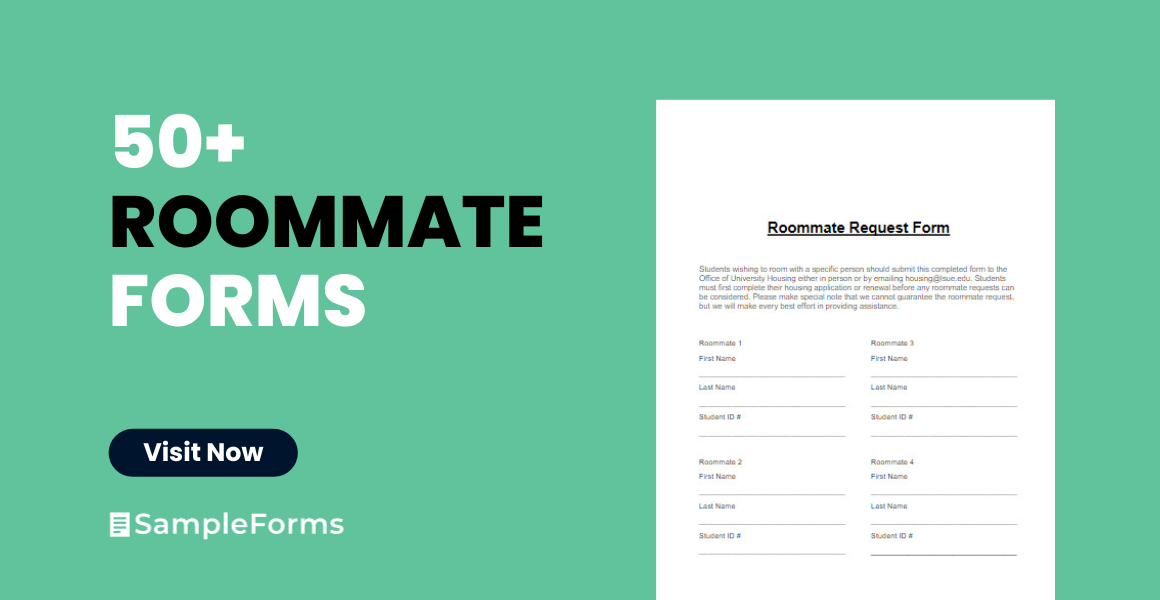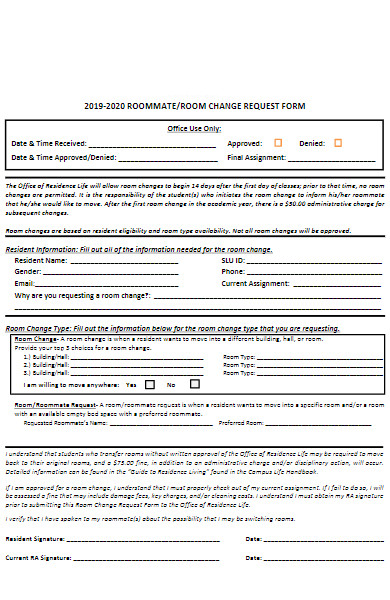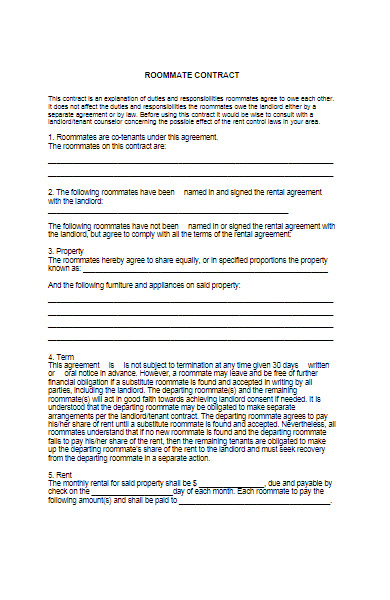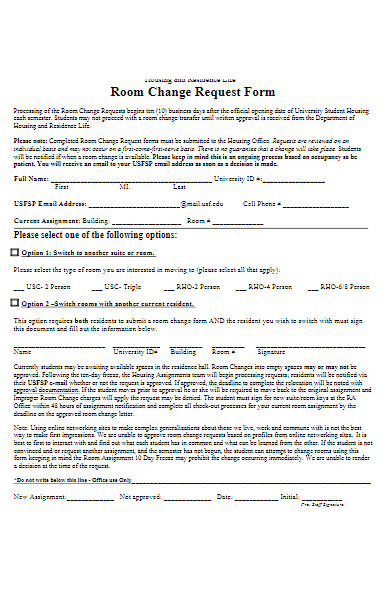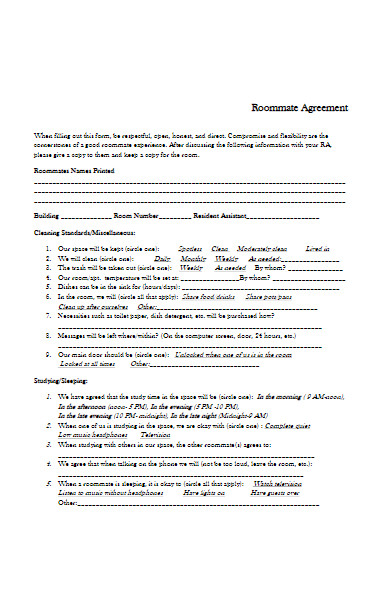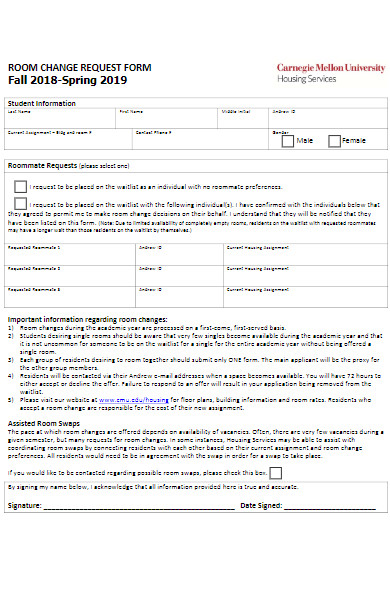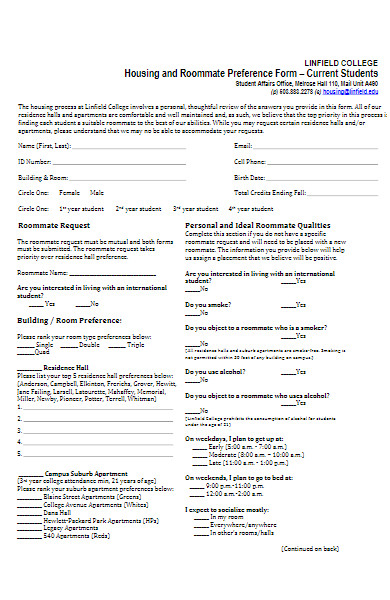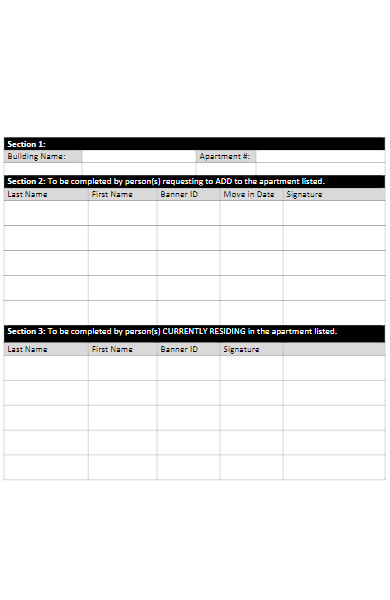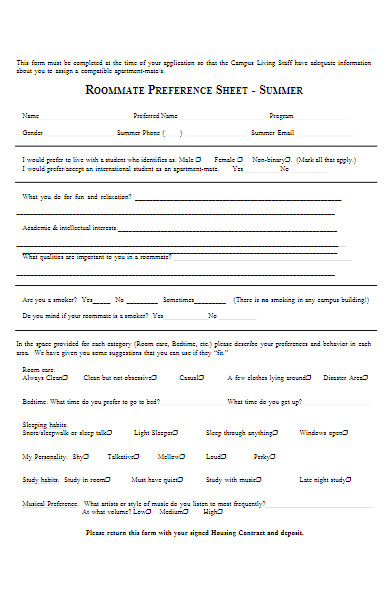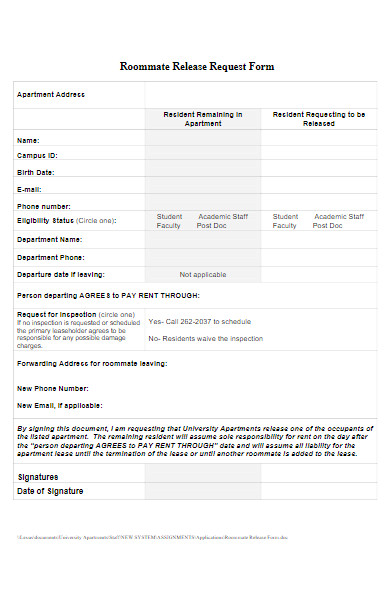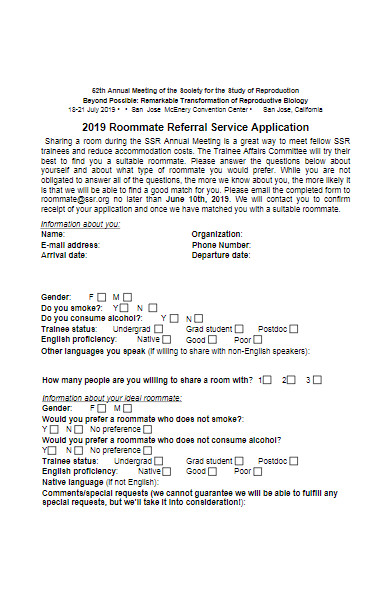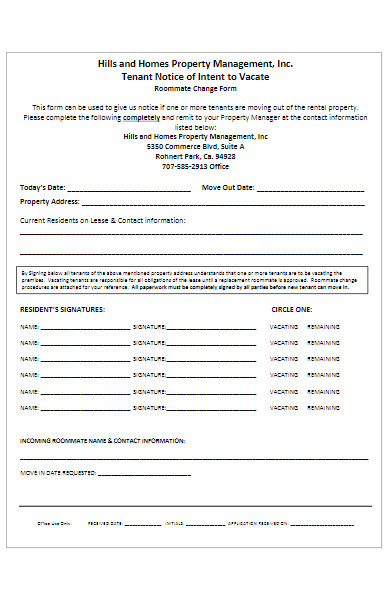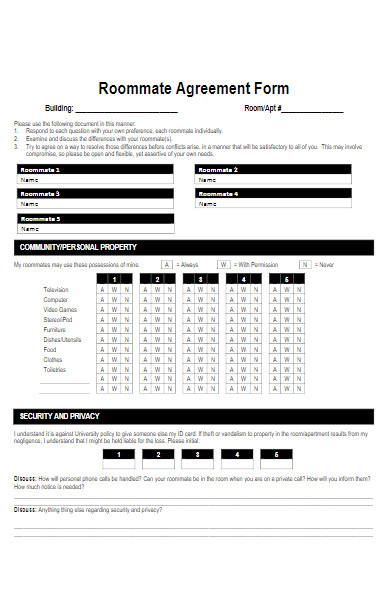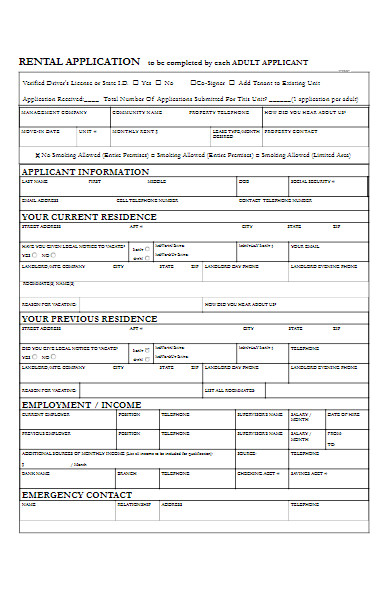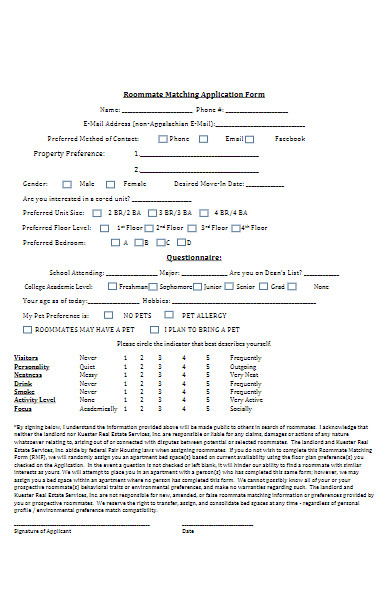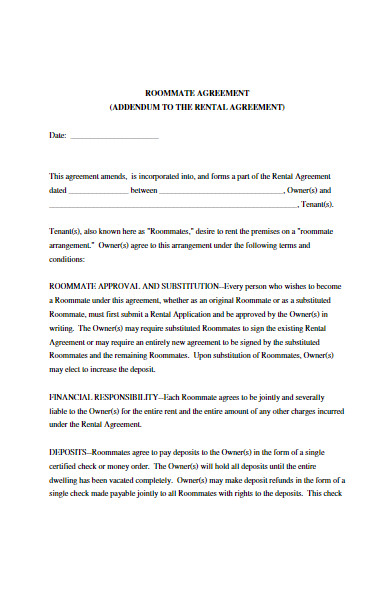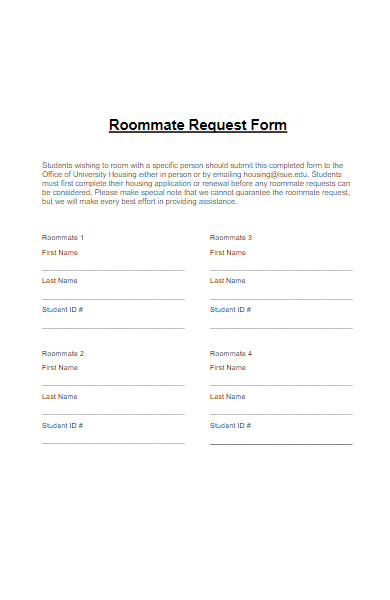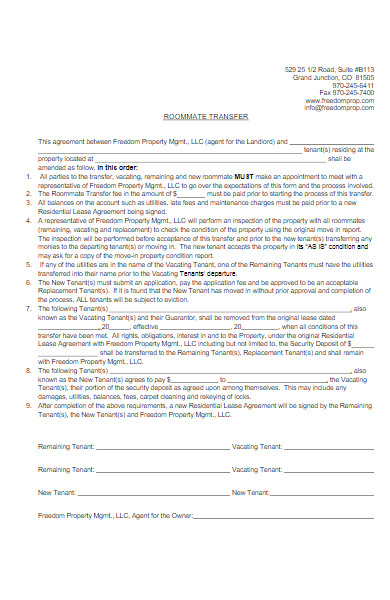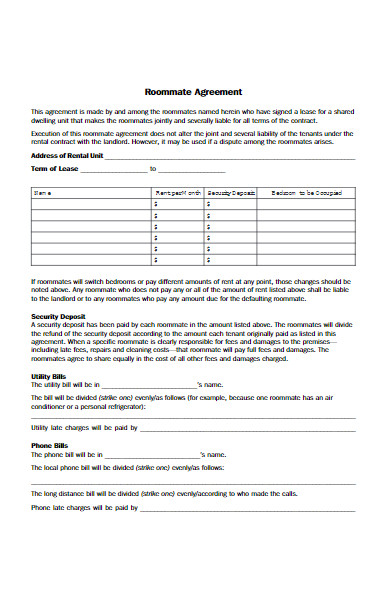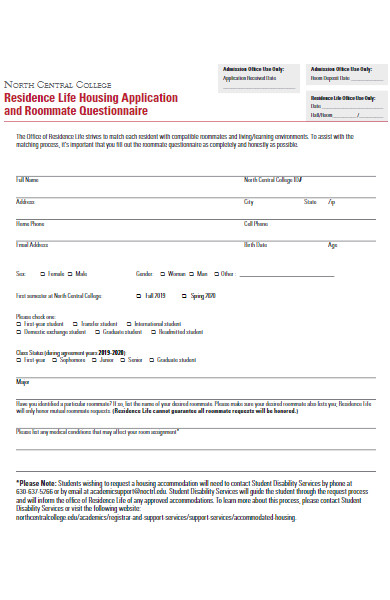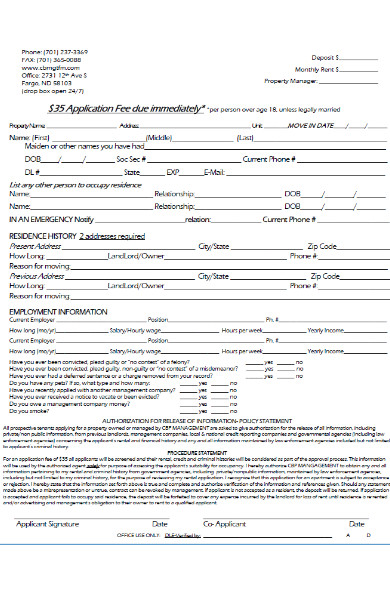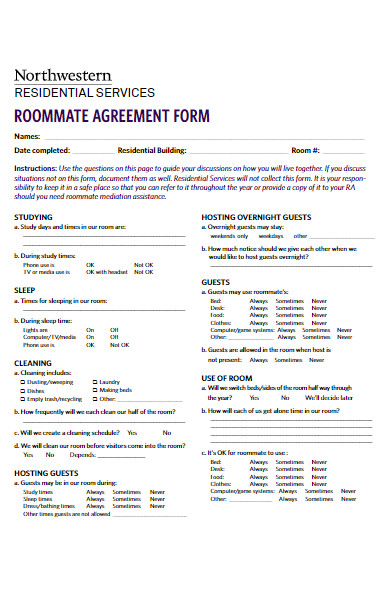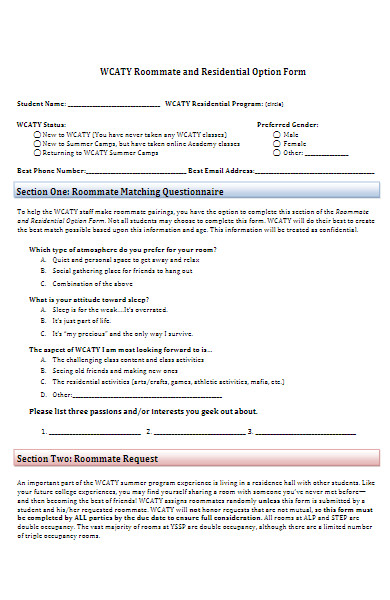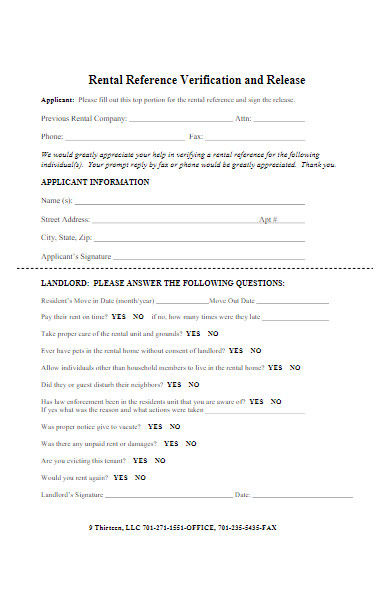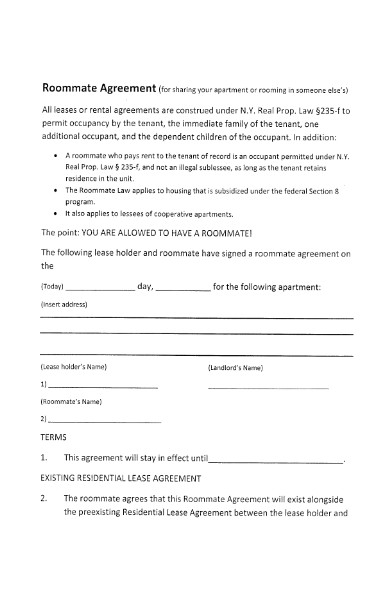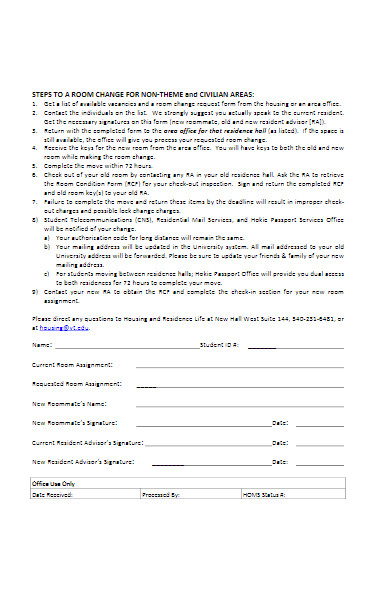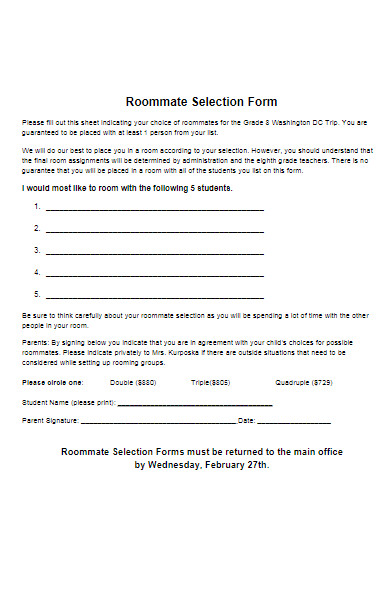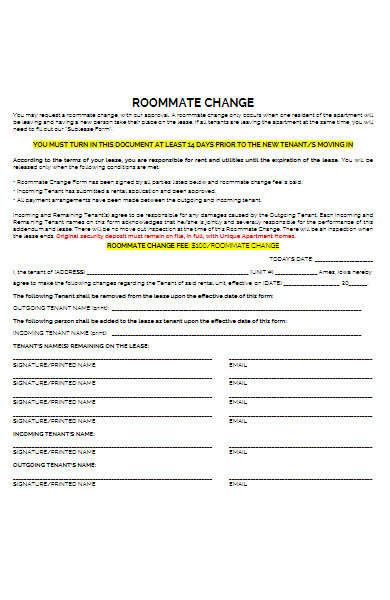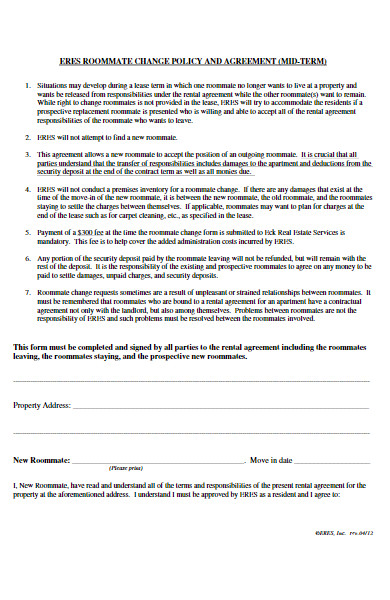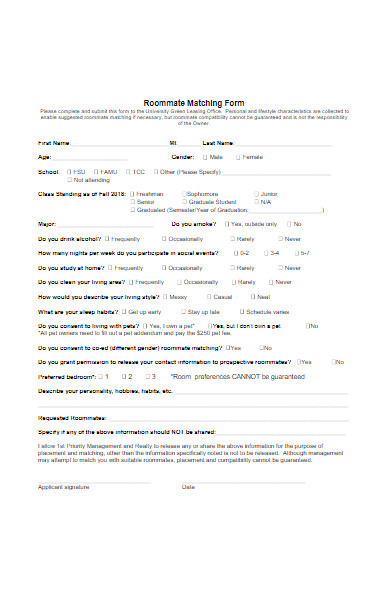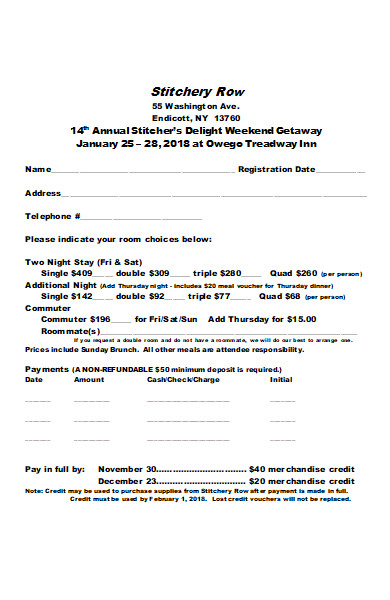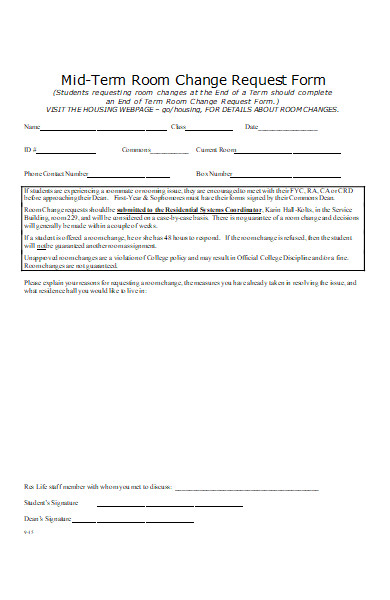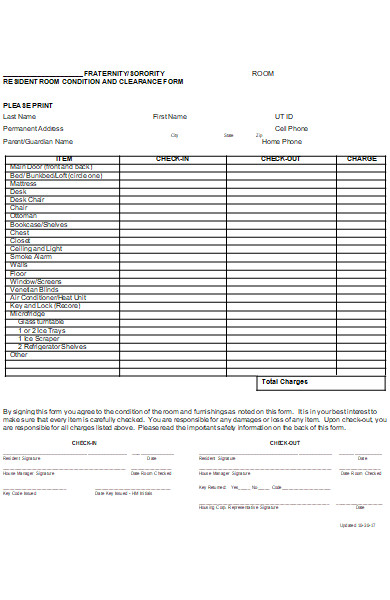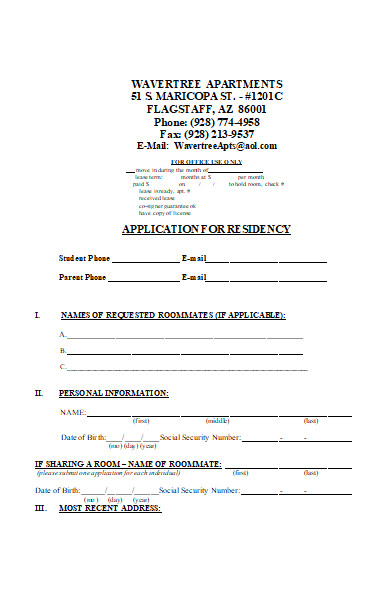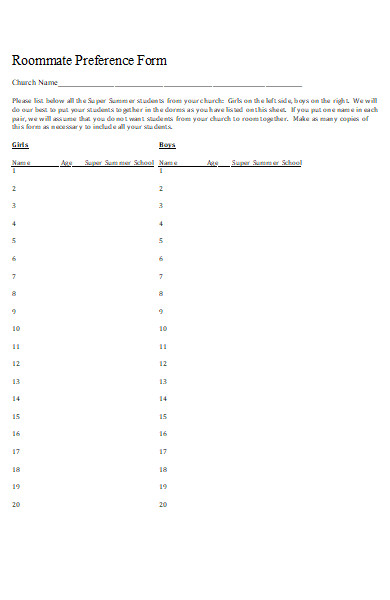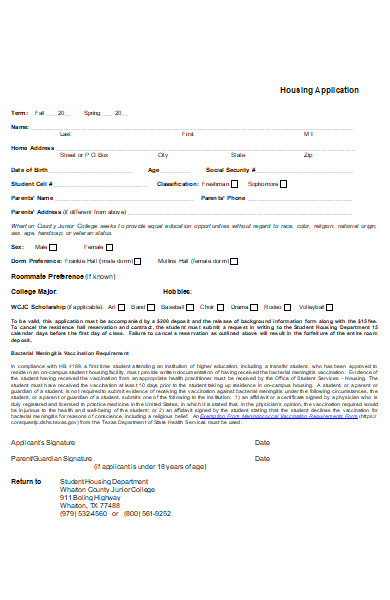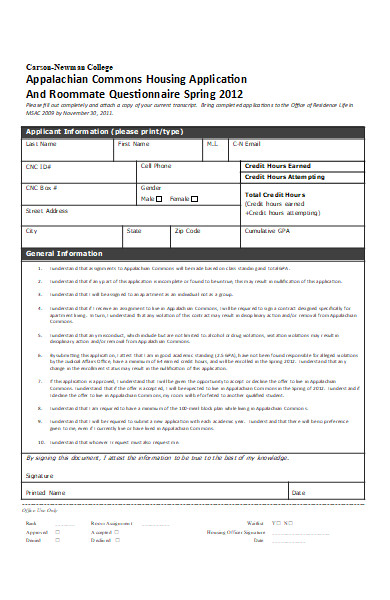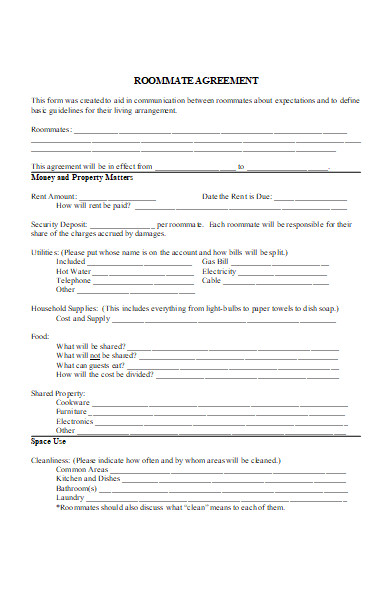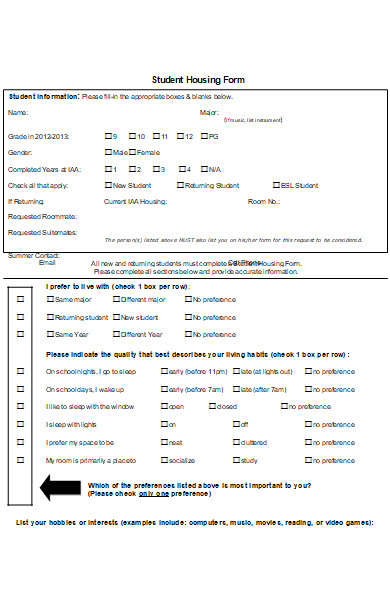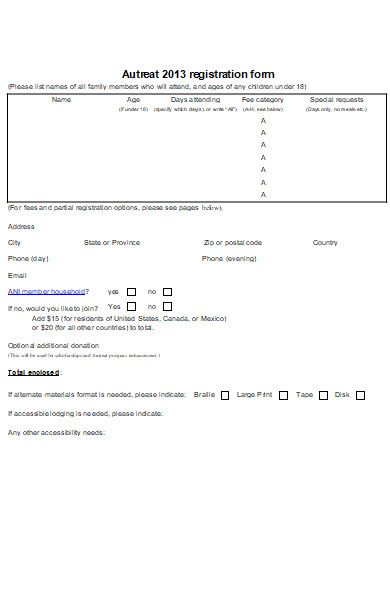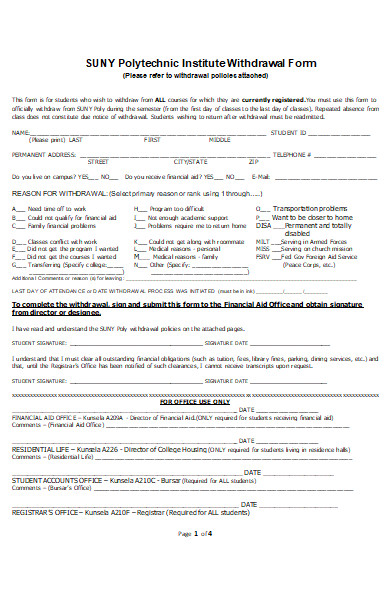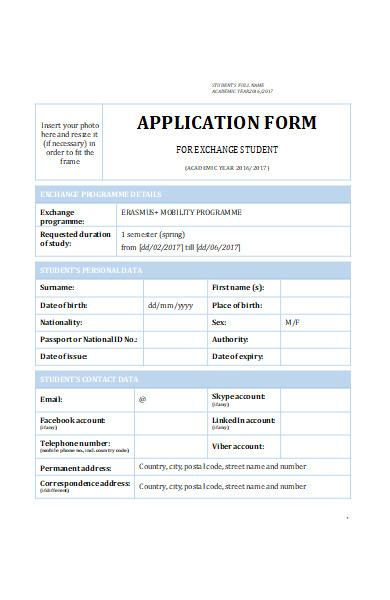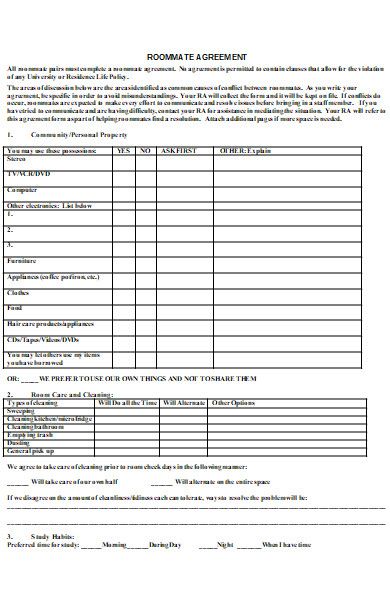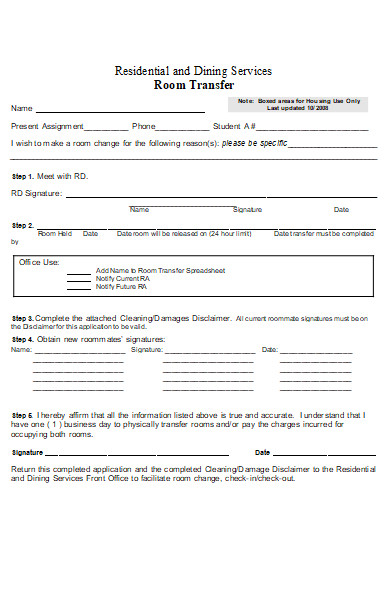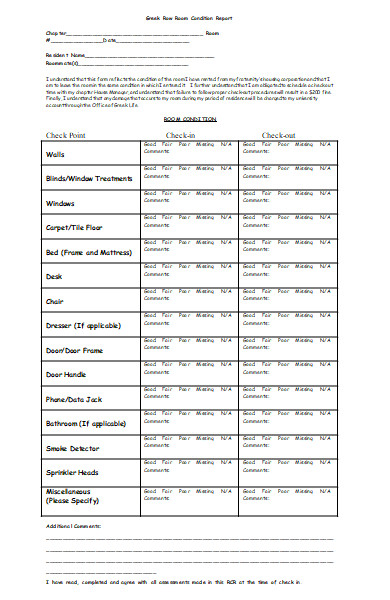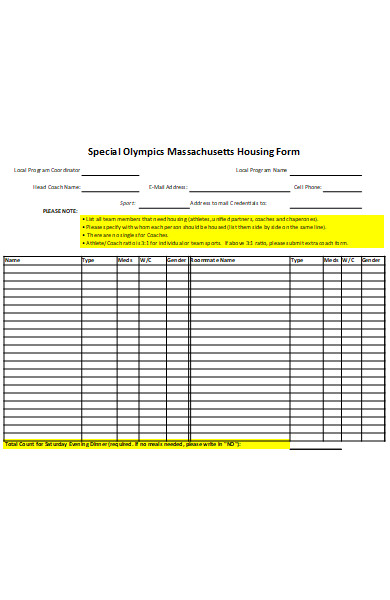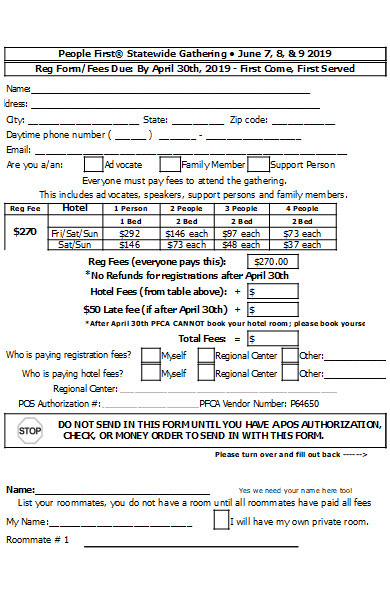Navigating shared living spaces requires understanding and agreement among roommates. A Roommate Form serves as a pivotal tool in this journey, laying out expectations and responsibilities. Whether delineating financial obligations, chores, or noise protocols, these printable form is essential for harmonious coexistence. Dive into the intricacies of roommate forms, exploring their significance, varied types, illustrative examples, and creation guidelines. Additionally, unearth valuable tips to maximize their efficacy, ensuring a smooth shared living experience.
What is a Roommate Form ? – Definition
A Roommate Form is a written agreement between individuals sharing a living space, outlining their respective rights, responsibilities, and expectations. It serves as a guideline for various aspects of cohabitation, such as rent and utility payments, housekeeping duties, noise restrictions, and conflict resolution methods. Unlike a lease agreement form, which is a binding contract between a tenant and a landlord, a roommate form focuses on the interpersonal aspects and logistics of sharing a residence among the occupants, ensuring clarity and minimizing potential disputes.
What is the Meaning of a Roommate Form?
The meaning of a Roommate Form revolves around its purpose as a tool for clarity and mutual understanding among individuals sharing a living space. It defines the terms of their cohabitation, detailing individual responsibilities, shared obligations, and house rules. By establishing these guidelines, these fillable form aims to prevent misunderstandings and conflicts. It’s a proactive measure, emphasizing open communication and collaboration, ensuring that all roommates have a clear picture of what’s expected of them and what they can expect from others in the shared living arrangement.
What is the Best Sample Roommate Form?
While the best roommate form can vary based on individual needs and the specific shared living situation, a comprehensive roommate agreement typically covers the following aspects:
Date: [Date]
Address: [Complete Address]
Roommates: [Names of all roommates]
-
Rent:
- Total Rent: [Amount]
- Each Roommate’s Share: [Amount per person]
- Due Date: [Date]
-
Utilities:
- Utility Bills Split: [Specify how the bills will be split, e.g., evenly among all roommates]
- Due Dates: [List due dates for each utility bill]
-
Security Deposit:
- Amount Paid by Each Roommate: [Specify amount]
-
Household Duties:
- Cleaning: [Specify cleaning responsibilities, frequency, and areas assigned to each roommate]
- Grocery Shopping: [Details about shared grocery shopping or individual responsibilities]
-
Quiet Hours:
- Specify quiet hours, e.g., 10 PM – 7 AM on weekdays
-
Guests:
- Overnight Guest Policy: [e.g., No overnight guests without prior notification to all roommates]
- Maximum Stay for Guests: [e.g., 3 consecutive nights]
-
Conflict Resolution:
- Agree on a method for resolving disputes, e.g., group meetings, mediation, etc.
-
Termination:
- Notice required to move out: [e.g., 30 days]
- Procedure for finding a replacement roommate
-
Personal Property:
- Respect for each roommate’s personal property
- Any shared property items and their care
-
Other Agreements:
- Any additional rules or guidelines agreed upon by the roommates, such as food sharing, use of common spaces, etc.
Signatures:
[Name of Roommate 1] ________________________ Date: __________
[Name of Roommate 2] ________________________ Date: __________
This sample can be adjusted based on the specifics of the shared living situation. Remember, open communication is crucial when crafting this document, ensuring all roommates feel represented and agreeable to the terms. It’s also recommended to review the blank form annually or whenever there’s a change in roommates.
FREE 50+ Roommate Forms
51. Roommate Registration Form in Excel
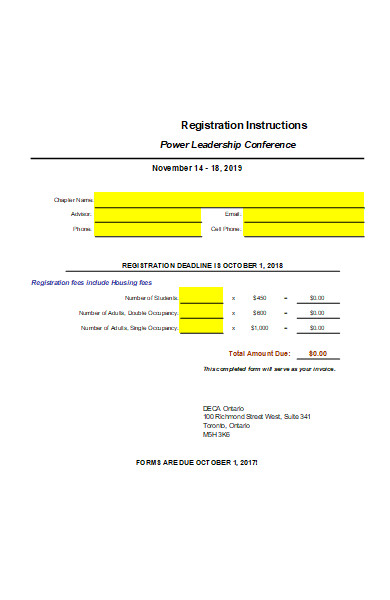
What is a Roommate Form and why is it necessary?
A Roommate Form, also often referred to as a roommate agreement, is a written document that outlines the terms and conditions agreed upon by individuals sharing a living space. It typically covers areas such as rent distribution, utility payments, housekeeping responsibilities, noise levels, guests, conflict resolution, and more.
The necessity of a Roommate Form arises from the following reasons:
- Clarity and Understanding: It provides a clear framework for the expectations and responsibilities of each roommate, ensuring that everyone is on the same page.
- Conflict Prevention: By addressing potential issues upfront, many common roommate disputes can be preempted. For instance, by establishing quiet hours or guest policies, roommates can avoid disagreements over these topics later on.
- Structure and Organization: The form provides a structured approach to shared living, detailing how bills will be split, when rent is due, and how chores are divided.
- Protects Individual Interests: Roommates can have varied lifestyles and preferences. The form ensures that each individual’s rights and interests are protected, fostering mutual respect.
- Flexibility: Unlike lease agreements with landlords, which are legally binding and standardized, roommate forms can be customized to suit the unique needs and preferences of the roommates involved.
- Documentation: Should disagreements arise, having a written agreement can serve as a reference point, reminding roommates of what they initially agreed upon.
- Promotes Open Communication: The process of creating a roommate form encourages roommates to communicate openly about their expectations, fostering a positive living environment from the outset.
In essence, while not always legally binding, a Roommate Form acts as a vital tool to ensure harmonious cohabitation, providing clarity, preventing disputes, and promoting mutual understanding and respect. You should also take a look at our roommate agreement form.
How do I create a Roommate Form that’s fair for everyone?
Creating a Roommate Form that’s fair for everyone requires open communication, collaboration, and consideration of all parties involved. Here’s a step-by-step guide to help ensure equity:
- Open Dialogue: Begin with an open discussion among all roommates. Encourage everyone to express their preferences, needs, and concerns. This initial conversation sets the foundation for a balanced agreement.
- List Key Points: Identify the primary aspects that need to be addressed in the form. These might include rent, utilities, chores, quiet hours, guests, and shared items.
- Be Specific: For each key point, delve into specifics. For example:
- Rent & Utilities: Clearly specify how much each person pays, when, and through which method.
- Chores: Create a rotating schedule or assign specific tasks to each individual.
- Quiet Hours: Determine specific times based on everyone’s routines.
- Seek Consensus: Ensure decisions are made collectively. If there’s a disagreement, discuss the issue until everyone reaches a compromise.
- Consider Different Lifestyles: Recognize and respect differences in schedules, social habits, and lifestyles. For instance, if one roommate works night shifts, adjust quiet hours accordingly.
- Review & Adjust: Once a draft of the form is ready, review it together. Allow roommates to suggest changes or voice concerns.
- Include a Conflict Resolution Section: It’s crucial to determine how you’ll address disagreements or breaches of the agreement. This might involve having a roommate meeting or seeking mediation.
- Keep it Flexible: Understand that circumstances change. Include a clause allowing for periodic reviews of the agreement (e.g., every six months) to make necessary adjustments.
- Document Everything: Once all terms are agreed upon, document them in the roommate form. Make sure it’s clear and understandable.
- Sign & Copy: Have all roommates sign the agreement and ensure each person has a copy. This reinforces commitment and serves as a reference if issues arise.
- Revisit & Revise: As mentioned, periodically revisit the agreement. If a new roommate joins or someone leaves, it’s a good time to review and modify the form.
- Consider Seeking Legal Advice: If you want to make your roommate agreement more formal or ensure you’re covering all bases, consider seeking advice from a legal expert.
Remember, the primary goal of a Roommate Form is to foster a harmonious living environment. It’s not about strict rules but about mutual understanding and respect. Keeping everyone’s best interests at heart and maintaining open communication are crucial for a fair and effective agreement. Our roommate rental agreement forms is also worth a look at
Can a Roommate Form be legally binding?
Roommate Form or roommate agreement is primarily an interpersonal agreement meant to manage the relationship and expectations between roommates. Whether it is legally binding depends on several factors:
- Jurisdiction: Laws differ from one jurisdiction to another. In some places, certain aspects of a roommate agreement might be enforceable, while in others, they may not be.
- Nature of Terms: If the terms in the form pertain to issues commonly addressed in contracts, such as financial obligations (e.g., sharing rent or utilities), they might be more likely to be enforceable. On the other hand, terms about personal habits or preferences (e.g., quiet hours or cleaning schedules) may be less likely to hold up in a legal setting.
- Clear and Definite Terms: For any contract to be enforceable, its terms generally need to be clear and definite. Vague or ambiguous terms can make enforcement difficult.
- Consideration: Contracts usually require some form of consideration or something of value being exchanged between parties. In the context of a roommate agreement, this might be the mutual promises made by roommates to each other.
- Legal Purpose: The terms of the agreement must be for a legal purpose. For instance, an agreement between roommates to engage in illegal activities would not be enforceable.
- Contradiction with Lease Agreement: If the roommate form contradicts the primary lease agreement with the landlord, the lease generally takes precedence. For instance, if the lease prohibits subletting but the roommate agreement allows it, the lease’s terms would typically prevail.
- Formalities: While many contracts can be verbal, having a written and signed document can provide clearer evidence of the agreement’s terms and the parties’ intent.
If roommates wish to have a legally binding agreement, it’s a good idea to consult with an attorney to understand local laws and ensure that the agreement is drafted in a way that meets legal requirements. Even if parts of the agreement are not legally enforceable, having a written document can still be beneficial for clarifying expectations and potentially mediating disputes between roommates. You also browse our Sample Room Agreement Forms.
What should be included in a Comprehensive Roommate Form?
A comprehensive Roommate Form should address various aspects of shared living to prevent misunderstandings and potential conflicts. Here’s a checklist of items you might consider including:
-
Basic Information:
- Names of all roommates
- Address of the shared property
- Duration of the agreement (start and end dates)
-
Financial Obligations:
- Rent: Amount each roommate pays, due date, and payment method.
- Utilities: How utility bills are split and their payment process.
- Deposits: Details about security deposits and conditions for return.
- Other expenses: Shared costs like internet, groceries, or household supplies.
-
Chores and Maintenance:
- Cleaning schedule: Who is responsible for what chores and how often.
- Maintenance responsibilities: Handling repairs or reporting issues to the landlord.
-
Shared Spaces & Personal Boundaries:
- Rules for using common areas like the kitchen, living room, or bathroom.
- Personal items: What can be shared and what’s off-limits.
-
Guests & Visitors:
- Policies about having guests over: Frequency, duration, notice required, etc.
- Overnight guests: Rules and any limitations.
-
Noise & Quiet Hours:
- Setting specific quiet hours, especially if roommates have different schedules.
-
Privacy:
- Respecting personal space and boundaries.
- Policies on entering each other’s rooms.
-
Conflict Resolution:
- A predetermined method for addressing disagreements or violations of the agreement.
- Possible mediation processes or third-party involvement.
-
Move-out & Early Termination:
- Notice required for moving out.
- Process for finding a replacement roommate, if necessary.
- Consequences or penalties for early termination of the agreement or lease.
-
Pets:
- Whether pets are allowed.
- Responsibility for pet-related chores and expenses.
- Rules and boundaries for pets in shared spaces.
-
Shared Items & Purchases:
- List of shared items and their respective owners.
- Process for purchasing new shared items or replacing old ones.
-
Food & Groceries:
- Shared food items and personal food boundaries.
- Cooking schedules, if applicable.
- Grocery shopping responsibilities and cost-sharing.
-
Parking:
- Assigned parking spots, if available.
- Rules and costs associated with parking.
-
Communication:
- Preferred methods and frequency of communication between roommates.
-
Modifications to the Agreement:
- Process for reviewing and updating the agreement if needed.
-
Signatures:
- A place for each roommate to sign and date, indicating their agreement to the terms.
It’s important to note that while this checklist covers many common areas of concern, every shared living situation is unique. Roommates should personalize the agreement forms based on their specific needs, preferences, and circumstances. It’s also beneficial to review the agreement periodically and make adjustments as the living situation evolves.
How often should we review and update our Roommate Form?
The frequency with which you should review and update your Roommate Form depends on several factors, but here are some general guidelines:
- Initial Adjustment Period: After first moving in together, there might be a period of adjustment as everyone settles into the new living situation. It could be beneficial to review the Roommate Form after the first month or two to address any unforeseen issues or areas of concern that have arisen.
- Change in Circumstances: Whenever there’s a significant change in one or more roommates’ circumstances, it’s a good time to revisit the agreement. Examples include:
- A roommate getting a pet
- A change in someone’s employment status or work schedule
- The introduction of a new romantic relationship that impacts the living situation
- Addition or Departure of a Roommate: If someone moves out or a new roommate moves in, it’s essential to review and likely revise the agreement to suit the new living dynamics.
- Periodic Reviews: Even if there aren’t significant changes, it’s a good practice to review the Roommate Form periodically. This could be every six months or annually. Regular reviews allow roommates to address small issues before they become bigger problems.
- Upon Renewal of Lease: If you and your roommates renew your lease, it’s an excellent time to revisit the agreement to see if any terms should be updated for the upcoming lease term.
- Conflict or Disagreements: If there’s a disagreement or conflict that isn’t clearly addressed in the current agreement, it might be a sign that the Roommate Form needs revisiting and possibly updating.
- Legal or Policy Changes: If there are changes in local housing laws or regulations, or if the property management introduces new rules, it might necessitate adjustments to the Roommate Form.
Remember, the primary purpose of a Roommate Form is to ensure clear communication and set mutual expectations. If all roommates maintain open communication, it becomes easier to recognize when it’s time to review and possibly update the agreement. Regular check-ins and discussions about the living situation can also prevent potential misunderstandings or conflicts. You should also take a look at our Rent a Room Agreement Forms.
How do I add a new Roommate to an existing Roommate Form?
Adding a new roommate to an existing Roommate Form requires some careful consideration and adjustments. Here’s a step-by-step guide on how to do it:
- Discussion with Current Roommates: Before adding a new roommate to the form, have an open conversation with the current roommates. Ensure everyone is on board with the new addition and address any concerns.
- Meet with the New Roommate: It’s crucial for the new roommate to understand the current agreement and provide input. Discuss the terms of the existing Roommate Form, and allow the new roommate to ask questions and suggest changes if needed.
- Review Financial Arrangements: With the addition of a new roommate, the financial split might change. Determine how rent, utilities, and other shared expenses will now be divided.
- Revise Responsibilities: Responsibilities such as chores, maintenance tasks, or other duties might need redistribution. Update the chore schedule or other responsibilities to accommodate the new roommate.
- Adjust Shared Spaces and Items: Consider the use of common areas and shared items. The addition of a new person might necessitate changes in shared spaces or the purchase of new shared items.
- Update Rules and Guidelines: Depending on the preferences and needs of the new roommate, you might need to modify some rules or guidelines. This could relate to quiet hours, guest policies, or other house norms.
- Draft the New Agreement: Once all changes have been discussed and agreed upon, draft a new Roommate Form or add an amendment to the existing form to include the new roommate’s details and any modifications to the original agreement.
- Signatures: All roommates, including the new one, should review the updated Roommate Form. Once everyone agrees to the terms, each person should sign and date the new or amended agreement.
- Inform the Landlord (if applicable): Depending on your lease agreement, you might need to inform your landlord about the new roommate. In many cases, the new roommate may need to undergo the same application and approval process as the original tenants.
- Keep Copies: Ensure that each roommate, including the new one, has a copy of the updated Roommate Form. This ensures everyone has access to the agreed-upon terms and responsibilities.
- Review Periodically: After adding a new roommate, consider reviewing the agreement after a short period (e.g., a month) to address any unforeseen issues or make further adjustments if needed.
Remember, the primary goal of updating the Roommate Form when adding a new person is to maintain harmony and clear communication within the household. Taking the time to discuss and agree on changes can help prevent misunderstandings or conflicts down the road. Our 30 day notice form is also worth a look at
How do I address shared expenses in the Roommate Form?
Addressing shared expenses in a Roommate Form is essential to ensure clear financial responsibilities and prevent disputes over money. Here’s a guide on how to detail shared expenses in the form:
- List All Shared Expenses: Begin by identifying all the shared expenses that roommates will incur. Common shared expenses include:
- Rent
- Utilities (electricity, water, gas, trash, etc.)
- Internet and cable TV
- Household supplies (cleaning products, toilet paper, etc.)
- Groceries (if you choose to share some or all food expenses)
- Shared services (e.g., cleaning services)
- Determine Splitting Mechanism: Decide how expenses will be split among roommates. There are different methods, such as:
- Equally among all roommates: Divide each expense by the number of roommates.
- By room size or usage: If some rooms are significantly larger or have private amenities, those occupants might pay more.
- By individual usage: For utilities like water or electricity, if someone uses significantly more or less, adjustments can be made accordingly.
- Designate a Payer: Decide who will be responsible for collecting money and paying each bill. Having one person handle a particular bill can streamline the process, but ensure responsibilities are evenly distributed to prevent undue burden on one individual.
- Payment Method: Decide on the preferred payment methods for shared expenses. Options include cash, checks, electronic transfers, or apps like Venmo or PayPal. Specify due dates, especially if they’re different from the official bill due dates.
- Late Payments: Outline consequences for late payments. This might include a grace period, potential late fees, or other repercussions.
- Documentation and Transparency: Establish a system for documenting expenses and payments. This could be a shared spreadsheet, an app, or physical receipts in a common area. Being transparent about expenses helps prevent misunderstandings.
- Unexpected or One-Time Expenses: Determine how unplanned expenses, like repairs or replacements, will be handled. Decide whether they will be split equally, by usage, or another method.
- Periodic Review: Establish a timeframe (e.g., every six months) to review and adjust the shared expenses if necessary. This is especially important if utility rates change, rent increases, or other financial aspects of the living situation evolve.
- Security Deposits (if applicable): Clarify how security deposits will be handled, both in terms of initial payment and potential deductions upon moving out.
- Conflict Resolution: Outline a method to address any disputes related to shared expenses. This might involve a third-party mediator, voting among roommates, or another mutually agreed-upon method.
Once all these points have been discussed and agreed upon, they should be clearly written down in the Roommate Form. Each roommate should review the contract form to ensure they understand and agree to their financial responsibilities. Lastly, all roommates should sign and date the form, and each person should keep a copy for their records.
How to Create a Roommate Form?
Creating a Roommate Form is crucial for maintaining a harmonious shared living environment. This step-by-step guide will help you create a comprehensive agreement:
- Title & Introduction:
- Begin with a title like “Roommate Agreement” or “Shared Living Agreement”.
- Include a brief introductory paragraph stating the purpose of the form.
- Roommate Details:
- List the names of all roommates.
- Specify the address of the shared residence.
- Duration of Agreement:
- Mention the start and end dates. This often aligns with lease dates, but it’s important to establish the period during which the agreement is valid.
- Rent & Security Deposit:
- Specify the total rent amount and how it’s divided among roommates.
- Detail how the security deposit is split and its return upon lease termination.
- Shared Expenses:
- Detail shared expenses, including utilities, groceries, and household supplies.
- Describe how expenses are split and the procedure for reimbursement.
- Household Duties:
- Divide household chores (cleaning, taking out trash, etc.) and specify who is responsible for each.
- Mention how often each chore should be completed.
- Quiet Hours & Guest Policy:
- Define quiet hours to ensure respect for each roommate’s peace and quiet.
- Describe any guidelines regarding guests, including how long a guest can stay.
- Food & Shared Items:
- Determine whether food is shared or separate.
- List any communal items that everyone can use (e.g., cleaning supplies, kitchen appliances).
- Personal Space & Common Areas:
- Define boundaries for personal spaces (bedrooms) and expectations for shared areas.
- Conflict Resolution:
- Describe how disagreements or breaches of the agreement will be addressed.
- Consider establishing a regular check-in or meeting to discuss any issues.
- Changes to the Agreement:
- Detail how and when the agreement can be amended, typically requiring mutual consent.
- Termination of Agreement:
- Explain circumstances under which the agreement can be terminated, such as a roommate moving out.
- Signatures:
- Provide a space for each roommate to sign and date, acknowledging that they agree to the terms.
Tips:
- Be Specific: The more details you include, the less room there is for misinterpretation.
- Stay Flexible: Living situations can change. Be open to revising the agreement as needed.
- Involve Everyone: Ensure all roommates participate in the discussion and agreement process.
- Keep Copies: Each roommate should have a copy of the signed agreement.
Lastly, remember that while a Roommate Form can be a useful tool for setting expectations and resolving disputes, it’s not necessarily legally binding like a lease. Its primary purpose is to promote clear communication and understanding among roommates. If legal issues arise, consult with a legal professional.
Tips for creating an Effective Roommate Form
Creating an effective Roommate Form ensures that everyone shares the same expectations and reduces potential conflicts. Here are some tips to keep in mind:
- Open Dialogue: Begin with an open conversation. Each roommate should express their preferences, concerns, and non-negotiables. This will lay the foundation for the form’s contents.
- Be Comprehensive: Cover all aspects of shared living, from financial responsibilities and chores to guest policies and conflict resolution.
- Use Clear Language: Avoid legal jargon. Instead, use simple and straightforward language so all roommates can easily understand.
- Be Specific: The more detailed the agreement, the less room for misunderstandings. For instance, instead of just mentioning “shared chores,” list out each specific task and who is responsible.
- Include a Conflict Resolution Section: Disputes are inevitable. Having a pre-agreed method to resolve conflicts can be invaluable.
- Stay Flexible: While it’s essential to stick to the agreement, life changes. Be open to revising the form when necessary, ensuring any modifications are agreed upon by all.
- Regularly Review the Agreement: Set a date, perhaps every six months, to revisit the agreement. This helps accommodate changes in living situations and address any emerging concerns.
- Document Everything: If there are financial transactions or other vital details discussed outside of the agreement, document them. Keeping records can prevent future disputes.
- Seek Input from All Roommates: Every roommate should have a say in the agreement. This ensures collective buy-in and makes everyone feel involved and responsible.
- Use Real-life Scenarios: While discussing potential rules or guidelines, use real-life examples to explain why a particular rule is necessary.
- Keep It Fair: Ensure that tasks, financial responsibilities, and other duties are evenly distributed among all roommates. Avoid letting one person bear the brunt of responsibilities.
- Sign and Date: Once all parties agree, each roommate should sign and date the agreement. This act formalizes the commitment to adhere to the outlined terms.
- Consider Digital Tools: Use online tools or apps designed for roommates to track expenses, chores, or other shared responsibilities. These tools can supplement the written agreement.
- Educate on Legal Responsibilities: While the Roommate Form sets internal guidelines, everyone should be aware of their legal responsibilities, especially if they’ve co-signed a lease.
- Encourage Open Communication: The Roommate Form is just a starting point. Encourage continuous open communication to address any issues before they escalate.
Remember, the primary purpose of the Roommate Form is to create a harmonious living environment. It’s not about setting strict rules but ensuring everyone is on the same page.
A Roommate Form is a comprehensive agreement outlining shared living expectations and responsibilities. Designed to foster understanding and harmony among roommates, it addresses aspects like rent, chores, and conflict resolution. While not necessarily legally binding, its true value lies in promoting open communication and setting clear guidelines. Properly implemented, it can greatly enhance cohabitation experiences and prevent potential disputes. You may also be interested in our Home Rental Agreement Forms and Notice to Vacate forms
Related Posts
Room Lease Agreement Samples
FREE 31+ Contract Agreement Sample Forms in PDF MS Word
FREE 5+ Lease with an Option to Purchase Agreement Forms in ...
FREE 9+ Sample Roommate Agreements in PDF MS Word
FREE 8+ Roommate Contract Samples in PDF - Sample Forms
FREE 12+ Sample Roommate Agreement Forms in PDF MS Word
FREE 5+ Real Estate Lease Guarantee Co-Signer Agreement ...
FREE 7+ Joint Venture Agreement Forms in PDF MS Word
FREE 30+ Agreement Forms in PDF MS Word
FREE 5+ Construction Subcontractor Agreement Forms in PDF MS ...
FREE 7+ Realtors Lease Agreement Forms in PDF
FREE 8+ Sample Shareholder Agreement Forms in PDF MS Word
FREE 9+ Sample Sublease Agreement Forms in PDF MS Word
FREE 11+ Sample Sublease Agreement Forms in PDF MS Word
FREE 10+Non-Disclosure Forms in PDF MS Word
